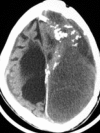Superimposed propionibacterium acnes subdural empyema in a patient with chronic subdural hematoma
- PMID: 19242574
- PMCID: PMC2640823
- DOI: 10.3340/jkns.2009.45.1.53
Superimposed propionibacterium acnes subdural empyema in a patient with chronic subdural hematoma
Abstract
The authors present a case of subdural empyema in a macrocephalic patient. A 23-year-old male was admitted due to headache and fever. One month ago, he had mild head injury by his coworkers. Physical examination showed a macrocephaly and laboratory findings suggested purulent meningitis. Neuroimaging studies revealed a huge size of epidural space-occupying lesion. Under the impression of epidural abscess, operation was performed. Eventually, the lesion was located at subdural space and was proven to be subdural empyema. Later, histological examination of the specimen obtained by surgery demonstrated finings consistent with the capsule of the chronic subdural hematoma. Two weeks after operation, Propionibacterium acnes was isolated. The intravenous antibiotics were used for total of eight weeks under monitoring of the serum level of the C-reactive protein. Follow-up brain computed tomography (CT) scan showed the presence of significant amount of remaining subdural lesion. However, he has complained of minimal discomfort. It is suggested that the subdural empyema occurred with preexisting chronic subdural hematoma after head injury about one month prior to admission and it took a long time to treat Propionibacterium acnes subdural empyema with systemic antibiotics, at least over eight weeks.
Keywords: C-reactive protein; Chronic subdural hematoma; Propionibacterium acnes; Subdural empyema.
Figures





Similar articles
-
[Subdural Empyema Caused by Propionibacterium Acnes after Burr-Hole Surgery of Chronic Subdural Hematoma:A Case Report].No Shinkei Geka. 2018 Jul;46(7):623-628. doi: 10.11477/mf.1436203780. No Shinkei Geka. 2018. PMID: 30049904 Japanese.
-
Chronic subdural hematoma infected by propionibacterium acnes: a case report.Case Rep Neurol. 2015 Jan 24;7(1):6-14. doi: 10.1159/000371841. eCollection 2015 Jan-Apr. Case Rep Neurol. 2015. PMID: 25759659 Free PMC article.
-
Subdural empyema complicated after trepanation and drainage of chronic subdural hematoma: A case report.Medicine (Baltimore). 2019 Dec;98(52):e18587. doi: 10.1097/MD.0000000000018587. Medicine (Baltimore). 2019. PMID: 31876760 Free PMC article.
-
Propionibacterium acnes causing delayed subdural empyema - a case report and review of literature.J Clin Neurosci. 2004 Aug;11(6):677-9. doi: 10.1016/j.jocn.2003.09.017. J Clin Neurosci. 2004. PMID: 15261253 Review.
-
Review of the Management of Infected Subdural Hematoma.World Neurosurg. 2016 Mar;87:663.e1-8. doi: 10.1016/j.wneu.2015.11.015. Epub 2015 Nov 14. World Neurosurg. 2016. PMID: 26585725 Review.
Cited by
-
A case of brain abscess caused by Propionibacterium acnes 13 months after neurosurgery and confirmed by 16S rRNA gene sequencing.Korean J Lab Med. 2011 Apr;31(2):122-6. doi: 10.3343/kjlm.2011.31.2.122. Korean J Lab Med. 2011. PMID: 21474989 Free PMC article.
-
Peculiar Case of Brain Abscess Caused by Propionibacterium acnes in an Immunocompetent Individual Without Prior Neurosurgical Intervention: A Case Report and Literature Review.Cureus. 2023 Aug 17;15(8):e43647. doi: 10.7759/cureus.43647. eCollection 2023 Aug. Cureus. 2023. PMID: 37724199 Free PMC article.
-
Pleural and Pericardial Infection Due to Cutibacterium acnes in a Splenectomized Patient: A Case Report of an Underreported Systemic Infection.Cureus. 2021 Mar 3;13(3):e13668. doi: 10.7759/cureus.13668. Cureus. 2021. PMID: 33824819 Free PMC article.
-
Fatal subdural empyema following pyogenic meningitis.J Korean Neurosurg Soc. 2011 Mar;49(3):175-7. doi: 10.3340/jkns.2011.49.3.175. Epub 2011 Mar 31. J Korean Neurosurg Soc. 2011. PMID: 21556239 Free PMC article.
-
Propionibacterium acnes brain abscess in a patient with HIV-1 infection.J Neurovirol. 2012 Apr;18(2):148-50. doi: 10.1007/s13365-012-0088-z. Epub 2012 Mar 9. J Neurovirol. 2012. PMID: 22403028 No abstract available.
References
-
- Barkhoudarian G, Hoff JT, Thompson BG. Propionibacterium infection associated with bovine pericardium dural allograft. J Neurosurg. 2005;103:182–185. - PubMed
-
- Chu RM, Tummala RP, Hall WA. Focal intracranial infections due to Propionibacterium acnes: report of three cases. Neurosurgery. 2001;49:717–720. - PubMed
-
- Ghalayini SR, Likhith AM, Golash A. Propionibacterium acnes causing delayed subdural empyema-a case report and review of literature. J Clin Neurosci. 2004;11:677–679. - PubMed
-
- Ide M, Jimbo M, Yamamoto M, Umebra Y, Hagiwara S. Asymptomatic calcified chrnonic subdural hematoma. Report of three cases. Neurol Med Chir (Tokyo) 1993;33:559–563. - PubMed
Publication types
LinkOut - more resources
Full Text Sources
Research Materials

